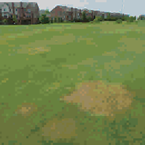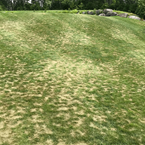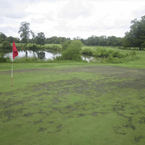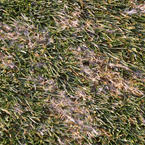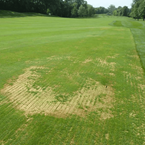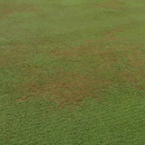Grey Snow Mould
Classification
// Problem
Pink and grey snow moulds are devastating turf diseases that occur on golf course putting greens, tees, and fairways in the presence of snow cover. These diseases are not only unsightly in the spring but can leave the turf surfaces unplayable. Both pink and grey snow moulds can affect all cool-season turfgrasses but tend to be more problematic on annual bluegrass and bentgrasses.
// What to look for
Grey snow mould, caused by Typhula sp., is active at 0-5 ºC with extended snow cover (greater than 80 days). Symptoms appearing at snow melt are light yellow to grey discoloured areas ranging from 7-30 cm or more in diameter. Matted turf progresses quickly to a greyish-white colour. As patches enlarge, a one-inch halo of greyish-white mycelial growth can appear at the surrounding margin. Individual patches may coalesce to form large affected areas. The key diagnostic feature is the presence of small, round, hardened sclerotia (chestnut brown for Typhula incarnata and black for Typhula ishikariensis). Pink snow mould can be distinguished from grey snow mould by the absence of these characteristic sclerotia.
Implementing proper cultural practices will assist in reducing disease severity. Management strategies include: avoiding late fall fertilization that leads to lush growth, controlling excessive thatch, removing tree leaves from the turf, controlling drifting snow, and removing snow/improving drainage to promote rapid drying in the early spring.
// Envu Solutions
Implementing proper cultural practices will assist in reducing disease severity. Management strategies include: avoiding late fall fertilization that leads to lush growth, controlling excessive thatch, removing tree leaves from the turf, controlling drifting snow, and removing snow/improving drainage to promote rapid drying in the early spring.
A pre-snow preventive application is critical for protecting vulnerable turf areas from snow mould. While disease symptoms develop under snow cover, sclerotia begin to germinate in the fall at 10-18 ºC. An additional application during this time period has been shown to reduce disease severity the following spring. After your last mowing of the season but prior to snow cover, a final fungicide application is needed. Products or mixtures containing 2-3 different active ingredients like Trilogy Stressgard and Interface Stressgard have been shown to provide exceptional snow mould control.
// Resources





